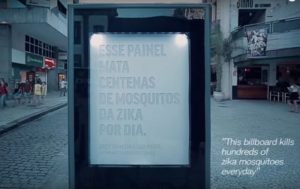Brazil has been called “Ground Zero” for the Zika virus and health officials around the globe are focused on fighting the disease. The Zika virus is thought to be linked to severe skull and brain defects in babies born in northeastern Brazil.
Billboards designed to kill mosquitoes have been put up all over the country, including in the city of Rio de Janeiro. The “mosquito killer billboards” have been designed to smell like humans to attract and trap the bugs. The smell they emit is created by a solution of carbon dioxide and lactic acid that replicates human breath and sweat. The solution can supposedly attract bugs from as far as 2.5 miles away. In addition to the solution, florescent lights are used to further entice the bugs, and when they are close enough, they are sucked into a trap by a vacuum, where they die.
Health officials hope this will help rid the country of the virus, but others say the billboards are also attracting bugs that are harmless to humans, but essential to the environment. Maya Gupta, head of the Animal and Society Institute in Atlanta says that while the lactic acid/carbon dioxide solution isn’t that appealing to other types of insects, the florescent lights “will attract all sorts of other types of insects.”
Despite the lack of proof that other bugs won’t be affected, there doesn’t seem to be much opposition to the billboards or the efforts to kill the mosquitoes. No word yet if the billboard use will spread to other parts of the world in an effort to completely eradicate the virus or at least to reduce the mosquito population.

